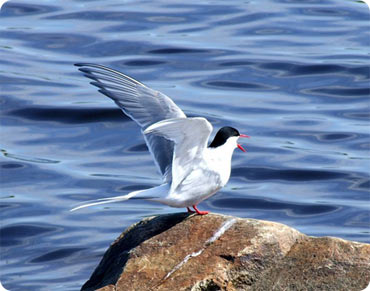The Arctic tern doesn’t look like a marathon winner. The bird is about a foot long and weighs just a few ounces. Yet this little dynamo spends a third of each year trekking between the Arctic Circle and the Antarctic Circle -- a twisting round-trip of almost 45,000 miles. That’s by far the longest known migration path of any bird.
 An Arctic tern in Finland. Credit: Wikipedia
An Arctic tern in Finland. Credit: WikipediaThe Arctic tern breeds at high northern latitudes -- from Alaska and Canada to Greenland, Scandinavia, and Siberia. When the northern summer draws to a close, though, it heads south.
European researchers tracked that migration. They attached tiny devices to a group of birds in Greenland in 2007, and recovered them when the birds returned the following year.
The trackers showed that the birds lingered in the North Atlantic for several weeks, feeding in waters that were rich with tiny shrimp-like creatures known as krill.
After that, two different colonies followed different paths southward. One hugged the coast of Africa, while the other crossed the Atlantic and hugged the coast of South America. But both colonies ended up in the Weddell Sea, on the coast of Antarctica.
The southbound trip took about three months. The return trip took only about half that long. The birds took a bit of a zigzag pattern, following the prevailing winds to conserve their energy.
Arctic terns can live for more than 30 years, making the same long-distance migration every year. Over the course of a lifetime, that’s enough miles to fly to the Moon and back -- three times.

